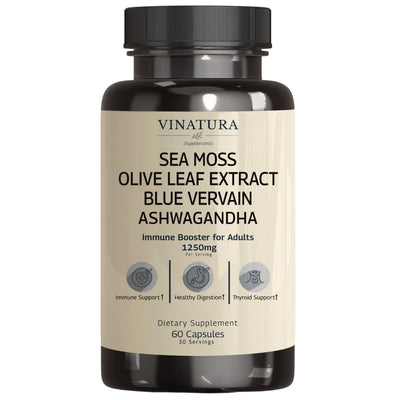
Pao Pereira Vs Rauwolfia Vomitoria: Can We Combine Them?
Pao Pereira vs Rauwolfia Vomitoria—can these two botanical extracts be safely and effectively combined?
Emerging preclinical research suggests that their unique mechanisms may complement one another, particularly in supporting cellular health, prostate function, and immune balance.
While Pao Pereira modulates inflammatory pathways like NFκB, Rauwolfia Vomitoria appears to regulate abnormal cell proliferation and vascular tone.
This article explores their individual properties, potential synergy, and safety considerations to help you determine whether combining these plant-based interventions may offer added wellness benefits—especially in challenging health contexts.
Before exploring further, please read the disclaimer located at the end of this webpage.
Key Takeaways
- Pao Pereira: May help support pain management, cognitive function, and general well-being. Traditionally used for its antimalarial properties and has demonstrated biological activity in preclinical studies, including on prostate health.
- Rauwolfia Vomitoria: Known for its traditional use in supporting cardiovascular health and promoting relaxation. It may also play a role in supporting male reproductive health, though it can be associated with certain side effects.
- Mechanism: Both ingredients have been shown to interact with damaged DNA and influence cellular processes such as apoptosis. Pao Pereira may help modulate NFκB activity, while Rauwolfia is thought to slow down abnormal cell proliferation.
- Combination Potential: The combined use of Pao Pereira and Rauwolfia Vomitoria is being explored for its potential to support healthy cellular responses, especially in challenging biological conditions, while being gentle on normal cells.
Individual Properties of Pao Pereira and Rauwolfia Vomitoria
Pao Pereira
Pao Pereira is a plant native to northern South America. It has a long history of use in traditional practices for supporting the body in cases of malaria, digestive discomfort, constipation, fever, liver-related symptoms, and low vitality [1].

Its key bioactive components include indole alkaloids, which have shown biological activity in lab studies. Among five alkaloids tested, geissolosimine exhibited notable effects against chloroquine-sensitive Plasmodium falciparum in vitro.
In animal models, both crude extracts and dichloromethane fractions of Pao Pereira were associated with responses involving 5-HT1A receptors—proteins known to play a role in mood and neurological regulation.
Read more: 5 Best Pao Pereira Supplements For Healthy Aging Support
Geissospermine, the most prevalent alkaloid, was observed in studies to inhibit acetylcholinesterase—an enzyme affecting acetylcholine levels in the brain. This mechanism has been linked to memory-related outcomes in preclinical trials [1].
Traditionally, the bark of Pao Pereira has been used to support wellness in areas such as digestive function, liver health, and immune response, as well as to promote general vitality [2].
Potential supportive benefits of Pao Pereira include:
- Malaria: Lab and animal studies suggest anti-malarial activity, though human research is limited [1].
- Fever: Folk use for reducing fever, but clinical evidence remains insufficient [1].
- Liver-related discomfort: Preclinical data suggests some analgesic properties; human trials have not confirmed this [1].
- Digestive support: Traditional use noted, though scientific validation is lacking [1].
- Cellular support: Early studies indicate possible protective effects at the cellular level [1].
- BPH management: In animal studies, Pao Pereira bark extract helped reduce prostate size associated with benign prostatic hyperplasia (BPH), potentially by modulating hormone-related proteins. These effects occurred without changes in weight or sperm count [3].
A consumer, Jody LaGreca, gave a five-star rating to a supplement containing 1000 mg of Pao Pereira, describing it as a "natural treasure" from the Amazon rainforest and commending its role in supporting immune and cellular health.*
Rauwolfia Vomitoria
Rauwolfia vomitoria is a natural herb that has been traditionally used for over 2,000 years to support cardiovascular and mental well-being [4].

Mechanisms of Action [5]:
- Cardiac Support: This plant may help promote heart rhythm stability by influencing myocardial excitability, atrioventricular conduction, and the heart's refractory period.
- Main Active Compound: Reserpine, a prominent indole alkaloid found in Rauwolfia, is associated with its blood pressure-supportive properties. Other alkaloids include ajmaline (noted for potential anti-arrhythmic effects), ajmalicine, raubasine, and yohimbinic acid.
-
Reserpine and Blood Pressure Regulation:
- May influence the central nervous system by modulating sympathetic and parasympathetic activity.
- Potentially interacts with adrenaline receptors, contributing to a calming effect on blood vessels.
- Binds to vesicular monoamine transporters (VMATs), possibly impacting the storage of neurotransmitters such as norepinephrine, which may help maintain healthy blood pressure levels.
- Vascular Effects: Rauwolfia may support vascular relaxation and contribute to healthy peripheral resistance and circulatory function.
- Neurological Influence: Reserpine appears to act on the hypothalamus and may help reduce norepinephrine activity, contributing to a mild sedative effect. This may be beneficial for individuals seeking relaxation during periods of stress or sleep disturbances.
Rauwolfia vomitoria (Apocynaceae) has also been noted for its traditional applications in various wellness contexts, including digestive and reproductive health.
"Rauwolfia vomitoria is recognized for its many therapeutic effects, especially in the treatment of diarrhea, malaria, hypertension, and male infertility." — Toxicity and Beneficial Effects of Some African Plants on the Reproductive System (Yakubu et al., 2015) [6].
In animal studies, 21-day administration of Rauwolfia vomitoria stem bark extract in male mice has shown dose-related physiological changes [6]:
- Reduction in body weight (dose-dependent)
- Increase in testicular, prostate, and seminal vesicle weights (notably at higher doses)
- Improved markers of reproductive function such as sperm production, motility, and transport time (especially at lower doses)
- Elevated levels of testicular protein, cholesterol, and testosterone
These findings suggest potential supportive effects on reproductive parameters in preclinical models.
Comparison Table
|
Criteria |
Pao Pereira |
Rauwolfia vomitoria |
|
Origin |
Native to northern South America |
Native to Africa, family Apocynaceae |
|
Traditional Uses |
Malaria, digestive issues, constipation, fever, liver pain, aphrodisiac, cancer. Notably, it reduces benign prostatic hyperplasia (BPH). |
Hypertension, mental disorders, diarrhea, malaria, male infertility |
|
Main Active Compounds |
Indole alkaloids (geissolosimine, geissospermine) |
Indole alkaloids (reserpine, ajmaline, ajmalicine, raubasine, yohimbinic acid, etc.) |
|
Main Mechanisms of Action |
|
|
|
Research Status |
Some preclinical studies, no human trials yet |
Animal studies conducted; Reserpine had past clinical use |
Can We Combine Pao Pereira and Rauwolfia Vomitoria?
Based on current research, Pao Pereira and Rauwolfia Vomitoria extracts may be used together, although additional studies and clinical trials are necessary to better understand their safety profile and potential supportive roles [7].
Some studies have observed that this combination may help support prostate health, including assisting in the maintenance of healthy PSA levels and alleviating common symptoms associated with benign prostatic hyperplasia (BPH), such as urinary frequency and flow—without reported adverse effects [8].
However, these extracts are not intended to treat or cure prostate cancer.

The study titled “Anti-cancer activity of extracts from Rauwolfia vomitoria and Pao Pereira” explored how these plant extracts interact with cancer cell lines, including those resistant to conventional chemotherapy agents such as gemcitabine and carboplatin [9].
In laboratory settings, combining the extracts with standard treatments was associated with enhanced activity against these resistant cells, while showing minimal toxicity to normal cells [9]. These findings point to the potential of these extracts as supportive adjuncts to existing therapies [9].
Another investigation found that combining Pao Pereira and Rauwolfia Vomitoria may help reduce the growth of ovarian cancer stem cell populations by interfering with the Wnt/β-catenin signaling pathway. Notable observations included:
- A reduction in ovarian cancer cell proliferation
- Limited impact on healthy cell lines
- A decrease in cancer stem cell activity
The Wnt/β-catenin pathway is known to play a key role in cell signaling related to growth and survival, and modulating this pathway may offer additional supportive advantages [7].
In summary, while these plant extracts are not cures, research suggests they may have complementary roles when used alongside conventional treatments—especially in cases involving drug-resistant cancers. They may also contribute to prostate wellness.
Nonetheless, due to the potential side effects associated with Rauwolfia, particularly, any use should be carefully guided by a healthcare professional.
Mechanism of Action of Pao Pereira and Rauwolfia Vomitoria
According to the study titled “Pao Pereira extract suppresses benign prostatic hyperplasia by inhibiting inflammation-associated NFκB signaling” (Dong et al., 2020), Pao Pereira extract has been observed to support cellular health in human prostate tissue by promoting programmed cell death (apoptosis) and modulating inflammatory NFκB signaling pathways.
The extract was shown to activate genes associated with cell self-regulation while lowering the expression of genes linked to inflammation and tissue remodeling in both cultured cells and human prostate tissue samples [10].
Rauwolfia vomitoria has also been studied for its potential to support healthy cellular behavior. In both laboratory and animal studies, the extract was associated with a reduction in abnormal cell growth and an increase in apoptotic activity in certain cell types [11].
These findings suggest that both Pao Pereira and Rauwolfia vomitoria may help maintain cellular balance by interacting with areas of compromised DNA and supporting natural mechanisms of cellular regulation.
Each plant appears to influence different aspects of cellular function:
-
Pao Pereira is associated with modulating NFκB signaling, a pathway often linked to inflammatory responses and cell survival processes.
-
Rauwolfia vomitoria may affect the cell division cycle, contributing to the regulation of abnormal cell proliferation.
Safety Profile of Pao Pereira and Rauwolfia Vomitoria
Safety evaluations of Pao Pereira have demonstrated no significant toxicity when used appropriately.
Research also indicates that it can be safely combined with chemotherapy, and some preliminary findings suggest it may support the effectiveness of certain chemotherapy protocols [12].
In contrast, Rauwolfia Vomitoria, while traditionally used for its supportive properties, has been associated with several potential side effects [4], including:
-
Lowered heart rate and blood pressure (due to vasodilation)
-
Decreased libido
-
Increased appetite accompanied by weight loss
-
Swelling, abdominal discomfort, dizziness, hallucinations
-
Impaired motor coordination and reduced physical stamina
-
Mood disturbances such as psychotic depression
As a result, understanding the safety profile and possible adverse effects of Rauwolfia Vomitoria is essential for its appropriate use in wellness or integrative health contexts.
Conclusion
Pao Pereira and Rauwolfia Vomitoria are botanical extracts that have drawn attention for their potential to support the management of various chronic conditions, including those related to immune function, cardiovascular health, and hormone balance.
Some research has explored their combined use in supporting individuals undergoing conventional therapies, such as chemotherapy or in addressing benign prostatic conditions.
However, further clinical studies are necessary to establish their long-term safety and practical benefits, particularly when used alongside standard medical treatments.
Testimonial Disclaimer
*The testimonials presented on this website are provided by individuals based on their personal experiences with our products. These testimonials represent individual opinions and experiences, which may not be typical or applicable to all users of our products. Results may vary depending on a variety of factors, including individual health, lifestyle, and adherence to product usage instructions.References
- [1] Pao pereira. Memorial Sloan Kettering Cancer Center. Published January 29, 2021. Accessed April 19, 2025. https://www.mskcc.org/cancer-care/integrative-medicine/herbs/pao-pereira
- [2] Pao Pereira: Health Benefits, Side Effects, Uses, Dose & Precautions. RxList. Published June 11, 2021. Accessed April 19, 2025. https://www.rxlist.com/supplements/pao_pereira.htm#UsesAndEffectiveness
- [3] Liu J, Fang T, Li M, et al. Pao Pereira Extract Attenuates Testosterone-Induced Benign Prostatic Hyperplasia in Rats by inhibiting 5α-Reductase. Scientific Reports. 2019;9(1). doi:https://doi.org/10.1038/s41598-019-56145-z
- [4] Isaiah A, Effiong E, Fidelis U, Olawale O, Idongesit N, Friday U. Vitamin E supplementation with Rauwolfia vomitoria root bark extract improves hematological indices. North American Journal of Medical Sciences. 2012;4(2):86. doi:https://doi.org/10.4103/1947-2714.93383
- [5] African Snake Root, Indian Snake Root (Rauwolfia vomitoria, R. serpentina) - Restorative Medicine. Restorative Medicine. Published 2025. Accessed April 19, 2025. https://restorativemedicine.org/library/monographs/african-snake-root/
- [6] Yakubu Musa Toyin, Ajiboye Taofeek Olakunle, Adewunmi AM. Toxicity and Beneficial Effects of Some African Plants on the Reproductive System. Elsevier eBooks. Published online January 1, 2014:445-492. doi:https://doi.org/10.1016/b978-0-12-800018-2.00015-7
- [7] Chen P, Dong R, Chen Q. Extracts of the Medicinal Plants Pao Pereira and Rauwolfia vomitoria Inhibit Ovarian Cancer Stem Cells In Vitro. Integrative Cancer Therapies. 2022;21. doi:https://doi.org/10.1177/15347354221123019
- [8] Clinical Trial on the synergistic effects of Rauwolfia vomitoria and Pao pereira on elevated PSA - The Beljanski Foundation. The Beljanski Foundation - Working To Cure Cancer The Natural Way. Published August 24, 2015. Accessed April 19, 2025. https://www.beljanski.org/beljanski-scientific-publications/clinical-trial-on-the-synergistic-effects-of-rauwolfia-vomitoria-and-pao-pereira-on-elevated-psa/
- [9] Yu J, Drisko J, Chen Q. P01.38. Anti-cancer activity of extracts from Rauwolfia vomitoria and Pao Pereira. BMC Complementary and Alternative Medicine. 2012;12(S1). doi:https://doi.org/10.1186/1472-6882-12-s1-p38
- [10] Dong Y, Liu J, Xue Z, et al. Pao Pereira extract suppresses benign prostatic hyperplasia by inhibiting inflammation-associated NFκB signaling. BMC Complementary Medicine and Therapies. 2020;20(1). doi:https://doi.org/10.1186/s12906-020-02943-2
- [11] Bemis D, Capodice J, Gorroochurn P, Katz A, Buttyan R. Anti-prostate cancer activity of a β-carboline alkaloid enriched extract from Rauwolfia vomitoria. International Journal of Oncology. Published online November 1, 2006. doi:https://doi.org/10.3892/ijo.29.5.1065
- [12] Dong, R., Chen, P., & Chen, Q. (2018). Extract of the Medicinal Plant Pao Pereira Inhibits Pancreatic Cancer Stem-Like Cell In Vitro and In Vivo. Integrative Cancer Therapies, 17(4), 1204–1215. https://doi.org/10.1177/1534735418786027
Author

Product Disclaimer
Including an ingredient or study does not evaluate, endorse, or recommend any Vinatura product or any third-party product. Some ingredients discussed may not be used in any Vinatura product.
The content of the articles has not been evaluated by the Food and Drug Administration (FDA) and is not intended to promote or endorse any specific product. Any products sold on this website are not intended to diagnose, treat, cure, or prevent any disease.
Opinions and Endorsements
Any claims, statements, or opinions expressed in the articles are those of the author(s) and do not necessarily reflect the views or opinions of the manufacturers of the dietary supplement products. The products sold on this website are separate from the content of the articles and are not directly endorsed or associated with the information presented here.
Liability Disclaimer
The author(s) of the articles, website, and manufacturers of the dietary supplement products do not assume any liability for any potential consequences arising from the use of the information provided in the articles. Ingredient effects, dosages, and safety vary by individual, formulation, and context; some ingredients interact with medications or may be unsuitable during pregnancy or lactation. It is recommended that individuals consult with a qualified healthcare professional before making any dietary or lifestyle changes, including the use of dietary supplements.
Product Usage
Please refer to the product labels and packaging for specific usage instructions and guidelines for the dietary supplement products sold on this website.
Customer Support
For any concerns or questions regarding the dietary supplement products, please contact our customer support team, who will be more than happy to assist you.





Leave a Comment
Be the first to comment.
What do you think?